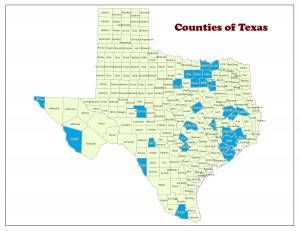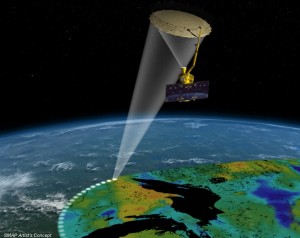
Philip Issa
Philip Issa is an news intern at StateImpact. He has previously written for Executive Magazine in Beirut, Lebanon, on transportation and entrepreneurship. Philip has also worked in the microfinance in the Middle East for Kiva, a global lender. He is pursuing his M.A. in Middle Eastern Studies from UT Austin and is expecting to graduate in May.
- Email: issa.philip@utexas.edu

Mose Buchele
Counties that contain at least one project applying for state funds are highlighted in blue.
The Texas Water Development Board (TWDB) had planned to distribute about $800 million in low interest loans for Texas water projects this year. By the time the deadline for project applications closed, total requests reached $5.5 billion, many of them from urban and suburban parts of the state.
The new system of financing was set up by state lawmakers and approved by voters in 2013. Under that system, billions of dollars were moved from the Texas Rainy Day Fund and put into a separate fund for water. The Water Development Board plans to distribute about $800 million dollars in loans every year for the next ten year.
The 48 projects eligible for loans this year range from modest to mighty. The City of Marfa asked for $700,000 to build a single well, but the North Texas Municipal Water District requested $791 million for the under-construction, 16,500 acre Lower Bois d’Arc reservoir.
Applications from the greater Houston metropolitan area comprise one third of the total requests received by the Water Development Board. The sixteen projects around Harris County alone add up to $3 billion in loan requests. Projects in the Dallas Fort Work area made up about ten percent of all requests.
Continue Reading →

Courtesy of NASA
The SMAP satellite will monitor drought levels around the globe.
A satellite launched by NASA over the weekend could help people around the world tackle the challenges of drought. Researchers at the University of Texas will play a part in that mission that could also help forecast flooding and allow officials to better manage reservoir water supplies.
The SMAP (Soil Moisture Active Passive) satellite that launched on Saturday will carry two devices to track drought. One to measure heat from the earth’s surface and the other a radar sensor to help pinpoint the location of the land surveyed. Researchers say that by using the two different technologies, they will get a clearer understanding of where the soil is parched and where it is well-saturated around the globe.
That information will be complimented with data gathered by soil moisture monitors, some of them installed around the Texas Hill Country by UT’s Bureau of Economic Geology. These on-the-ground sensors will help validate and improve the satellite’s readings.
Continue Reading →

